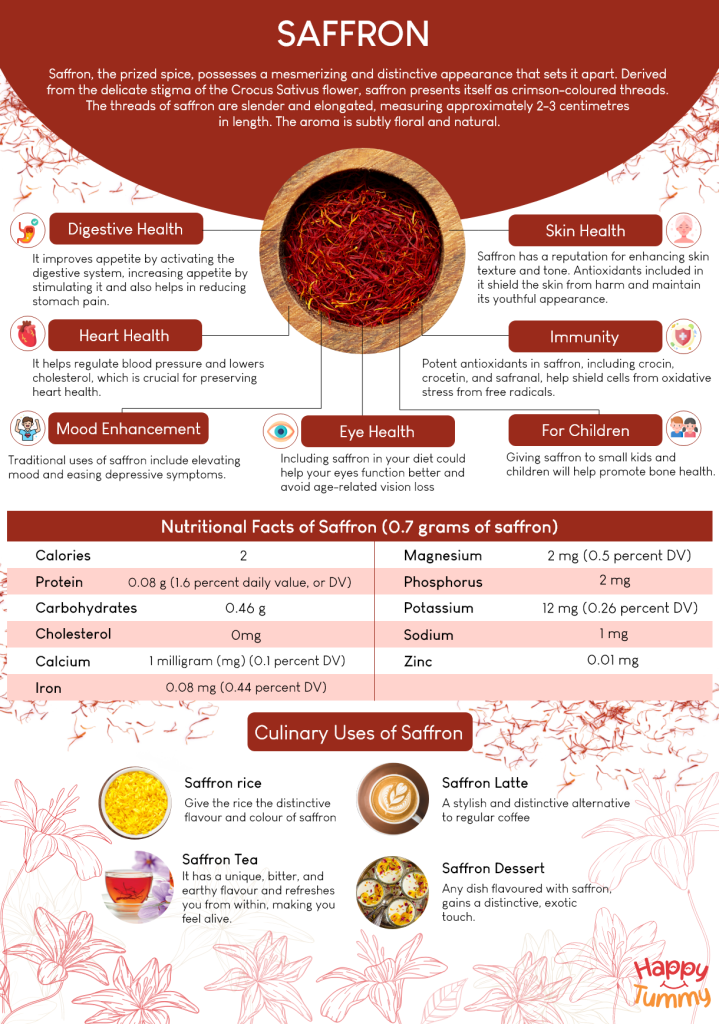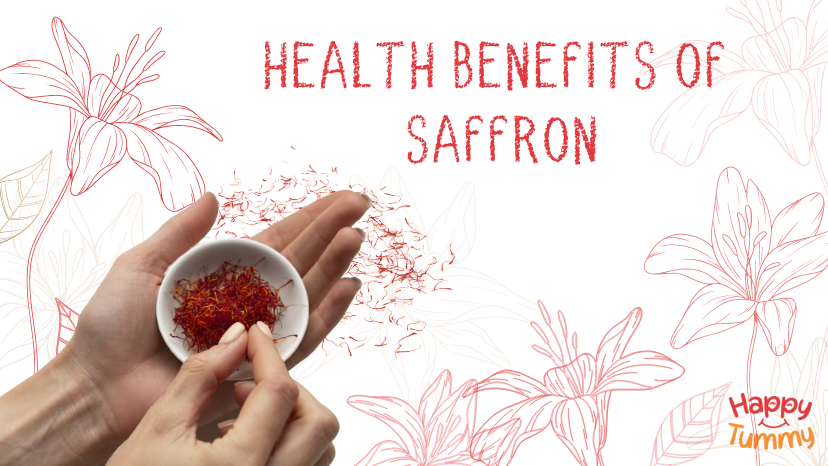Table of Contents
Are you feeling blue or sluggish lately? Worry no more! Let’s introduce you to saffron’s health benefits — sure to enlighten your day! Saffron is known as the world’s most expensive spice because of its tedious harvest process.
The stigma of the Crocus sativus flower is hand-picked, thus only producing a few grams per flower.
Its slender crimson threads and vibrant red colour stand as a testament to its rarity and culinary value.
Whether adorning a dish or being delicately handled, saffron captivates with its beauty and promises a sensory journey like no other.
Since ancient times, people have utilized this spice for its culinary and medicinal properties in many different cultures, including the Middle East, India, and Europe.
About Saffron(Kesar)
Saffron, the prized spice, possesses a mesmerizing and distinctive appearance that sets it apart.
Derived from the delicate stigma of the Crocus Sativus flower, saffron presents itself as crimson-coloured threads. Its appearance is captivating and instantly recognizable.
The threads of saffron are slender and elongated, measuring approximately 2-3 centimetres in length.
They are remarkably thin, resembling delicate red strands. Each thread has three distinct parts: the bright red stigma, the yellow style, and the pale white or yellowish stem.
The stigma carries the distinctive flavour, aroma, and vibrant colour for which saffron is renowned.
However, premium saffron usually has an intense, brilliant red colour with orange overtones, which denotes its potency and freshness. The texture is delicate yet powerful, with notes of honey, hay, and a touch of bitterness.
The aroma is subtly floral and natural. Both ancient Greek and Roman mythology make mention of it.
Its acceptance is expanding globally as more people become aware of its possible health advantages.
Nutritional Facts of Saffron
Here is the nutritional information for one teaspoon (tsp), or 0.7 grams (g), of saffron, as provided by the U.S. Department of Agriculture (USDA) [1].
| Nutrient | Quantity |
| Calories | 2 |
| Protein | 0.08 g (1.6 percent daily value, or DV) |
| Carbohydrates | 0.46 g |
| Cholesterol | 0 mg |
| Calcium | 1 milligram (mg) (0.1 percent DV) |
| Iron | 0.08 mg (0.44 percent DV) |
| Magnesium | 2 mg (0.5 percent DV) |
| Phosphorus | 2 mg |
| Potassium | 12 mg (0.26 percent DV) |
| Sodium | 1 mg |
| Zinc | 0.01 mg |
The Health Benefits of Saffron(Kesar)

Saffron is known for its numerous health benefits since it contains essential nutrients for our body.
1. Saffron (Kesar) helps to improve Digestive Health
If you seek ways to boost your digestive health, saffron may rescue you.
Firstly, it improves appetite by activating the digestive system, increasing appetite by stimulating it. People who lose appetite due to conditions like illness or medicine will find this extremely beneficial [2].
Second, due to its pain-relieving properties, saffron helps reduce stomach pain.
Lowering inflammation and calming the gut lining eases bloating and cramps.
Therefore, consider including a pinch of saffron in your food if you ever experience a stomach-ache once more. You’ll feel good in your gut.
Often you might wonder if your digestive health is on track or off track. However, with a two-minute test designed by Aashirvaad Atta with Multigrains, you can obtain valuable insights into your Digestive Quotient and make informed decisions about your diet and nutrition.
Aashirvaad Atta with Multigrains
Aashirvaad Atta with Multigrains aims to simplify assessing and improving your digestive health, providing the tools to embark on a journey toward a happier and more comfortable digestive experience.
Digestive Quotient
By taking their Digestion Quotient test, developed in collaboration with professional nutritionists, you can easily determine your digestion score on a scale 100.
You can use this scorecard to plan your meals effectively and track your progress toward a happy and healthy tummy.
2. Helps to improve Heart Health
Saffron looks more than just a culinary seasoning; it could also hold the key to heart wellness. It helps regulate blood pressure and lower cholesterol, which is crucial for preserving heart health.
This red gold could therefore lengthen and enhance the quality of your life and make meals more intriguing [3].
Who would have imagined that a tiny spice could have such a significant impact? So go ahead and season your grilled vegetables or breakfast porridge with saffron; your heart will be grateful.
3. Saffron helps to improve Eye Health
Are you sick of having your eyes strained from gazing at devices all day? Including saffron in your diet could help your eyes function better and avoid age-related vision loss [4].
This is excellent news for people who enjoy spending hours scrolling through Instagram and binge-watching Netflix shows.
But it’s not just for techies or movie addicts – saffron’s vision-boosting properties can benefit anyone who wants to maintain healthy eyesight.
So add a pinch of saffron to your rice or tea to reap the benefits. Your eyes will thank you.
4. Saffron(Kesar) helps to improve Skin Health
Who doesn’t want healthy, glowing skin? Well, saffron may be the answer to your prayers.
Saffron has a reputation for enhancing skin texture and tone. Antioxidants included in it shield the skin from harm and maintain its youthful appearance.
It additionally offers anti-aging qualities.
Saffron can help you retain tighter, younger-looking skin by making fine lines and wrinkles less noticeable if you include it in your regular diet or skincare regimen [5].
As a result, this red gold has numerous advantageous impacts on skincare, including its capacity to enhance and brighten the appearance of the skin, its relaxing qualities, anti-aging advantages, nourishing hydration, and cleansing powers.
So don’t just wait; go and unlock the beauty secrets of saffron and embrace its transformative powers for radiant and glowing skin.
5. Saffron for Immunity
Potent antioxidants in saffron, including crocin, crocetin, and safranal, prevent cells from oxidative stress from free radicals.
These antioxidants might help lower the risk of chronic illnesses and cell damage.
The saffron’s anti-inflammatory, antioxidant and other medicinal properties can help in pre- and post-infection management strategies [6].
6. Saffron for Mood Enhancement
Traditional uses of saffron include elevating mood and easing depressive symptoms. According to research, saffron may manage depression by raising specific neurotransmitters like serotonin levels [7].
7. Saffron Benefits for Children
Giving saffron to small kids and children will help promote bone health. It helps to absorb calcium and supports healthy bone development.
Moreover, it would help if you had a pinch of saffron powder or a single strand to feed your kid with milk and witness great results.
Cultural Significance of Saffron
Saffron has significant cultural importance in India and is ingrained in many facets of daily life. It is cherished for its culinary applications and symbolic, spiritual, and religious significance.
Saffron has a significant religious significance in Hindu rituals and festivities. It is offered to deities in temples and used to mark foreheads as a symbol of auspiciousness and purity.
It’s vivid colour is linked to power, fire, and divinity.
To give the food a unique flavour and improve its aesthetic appeal, it is also a crucial component in making traditional Indian sweets and celebratory foods like kheer (rice pudding) and biryanis.
Culinary Uses of Saffron
Saffron is used as a spice because of its distinct flavour, aroma, and therapeutic benefits. This golden strand is charming, as being the finest spice used in Indian and Middle Eastern cuisine.
It is the main component of regal dishes and sweets in many cultures.
Even the best chefs include saffron in their dishes. Saffron, which imparts a rich, yellow light to meals and beverages alike, is regarded as the emblem of royalty. You can use it in making desserts, tea, and rice, among other dishes.
Saffron rice is a delicious traditional meal that is simple to make. To give the rice the distinctive flavour and colour of saffron, simply add a few strands of it as it cooks.
The rice has a delicate, fragrant flavour and a lovely golden tint. It is usually served as a side dish or as the foundation for flavourful curries and stews since it goes well with various cuisines.
Next is saffron tea; try drinking it for its numerous health benefits. It has a unique, bitter, and earthy flavour and refreshes you from within, making you feel alive.
On the other hand, the saffron latte is a stylish and distinctive alternative to regular coffee. It goes nicely with fruit flavours in blended beverages, so try it! Upgrade your drinking experience with saffron.
Likewise, saffron dessert options are virtually limitless. Any dish with this spice, including ice cream made with saffron, cakes, and pastries flavoured with saffron, gains a distinctive, exotic touch.
So pick your favourite saffron recipe, and let this spice unleash its magic in your kitchen!
The Final Say
Surprised? Yes, the spice is capable of all of that and more. The best part is how simple it is to incorporate it in your diet. You can get by with a bit of saffron sprinkled here and there.
Just make sure the saffron you buy is excellent grade and authentic. So, for a good reason, saffron is a trendy spice.
The sunny spice has many significant health advantages, from helping with weight loss to boosting mood.
So, if you want to show your heart some love, start including saffron in your cooking immediately.
Frequently Asked Questions
Excessive consumption may have side effects like low blood pressure, dizziness, allergic reactions, and digestive issues. Consuming saffron in moderation is essential. Please consult your healthcare professional for any concerns before consuming it.
If you face any allergies or susceptible to it should avoid them. Pregnant women should use consult their doctor before ingesting saffron because it can potentially have uterine-stimulating effects.
There isn’t a set guideline for saffron dosage; instead, recommendations for daily use vary. However, a standard consumption range is between 20 and 30 milligrams or a few strands. Remember that each person will respond to saffron differently, so it’s better to see a healthcare professional for guidance.
Saffron milk can be healthy if consumed occasionally. The potential health benefits of saffron milk, which include antioxidant and mood-lifting properties, are widespread. However, consuming it in moderation is crucial.
It will be best to drink saffron milk on an empty stomach first thing in the morning. You can also have saffron milk before bed for maximum benefits because it will promote restful sleep.
To keep the flavour intact, keep saffron in an airtight container in a dark, cool place for up to six months. Like most spices, it is light-sensitive, so wrap the packet in foil to further shield it. Saffron will not spoil, but it will lose increasingly more and more of its flavour with age.
















